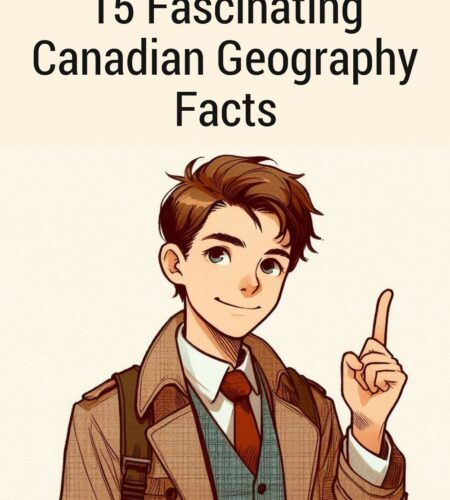Introduction:
Canada is a vast and diverse country that is known for its stunning landscapes and unique geography. From towering mountain ranges to expansive prairies and beautiful coastlines, Canada offers a wealth of geographical wonders to explore. In this article, we will delve into 15 fascinating Canadian geography facts that will surely leave you in awe of this incredible country.
Fact 1: The Great Lakes
Canada is home to the largest freshwater lake system in the world, known as the Great Lakes. These interconnected lakes, located on the Canada-United States border, consist of Lake Superior, Lake Michigan, Lake Huron, Lake Erie, and Lake Ontario. These lakes not only provide breathtaking views but also serve as important transportation routes and a valuable source of fresh drinking water.
Fact 2: The Rocky Mountains
Stretching from British Columbia to Alberta, the Rocky Mountains are a majestic mountain range that offers stunning vistas and incredible outdoor recreational opportunities. Mount Robson, located in the Canadian Rockies, is the tallest peak in the range, standing at an impressive 3,954 meters (12,972 feet) tall. The Rockies are not only a popular destination for outdoor enthusiasts but also serve as a natural divide between the Pacific and Atlantic drainage systems.
Fact 3: The Northern Lights
One of nature’s most mesmerizing phenomena, the Northern Lights, also known as the Aurora Borealis, can be seen in parts of Canada. The Northwest Territories, Yukon, and Nunavut offer some of the best viewing opportunities for this incredible display of dancing lights in the night sky. The Northern Lights are caused by collisions between electrically charged particles from the sun and the Earth’s atmosphere, creating vibrant and colorful displays.
Fact 4: The Canadian Shield
Covering approximately half of Canada’s land area, the Canadian Shield is one of the oldest rock formations in the world. It is composed of ancient volcanic rocks and is known for its abundance of lakes, rivers, and dense forests. The Canadian Shield is a vital part of Canada’s geography and is rich in mineral resources such as gold, silver, and uranium.
Fact 5: The Bay of Fundy
Located between the provinces of New Brunswick and Nova Scotia, the Bay of Fundy is known for having the highest tides in the world. The tides in the Bay of Fundy can rise and fall as much as 16 meters (52 feet) twice a day. This incredible natural phenomenon creates a unique ecosystem and provides the perfect environment for various marine species, including endangered whales.
Fact 6: The Prairies
The Canadian Prairies, also known as the breadbasket of Canada, are vast grasslands that stretch across several provinces, including Manitoba, Saskatchewan, and Alberta. These fertile plains are characterized by their wide-open spaces, golden fields of wheat, and stunning sunsets. The Prairies are essential for Canada’s agricultural industry and contribute significantly to the country’s economy.
Fact 7: Niagara Falls
One of Canada’s most famous landmarks, Niagara Falls, is a magnificent waterfall located on the border between Ontario and the United States. It is composed of three waterfalls: the Horseshoe Falls, the American Falls, and the Bridal Veil Falls. Niagara Falls is not only a popular tourist attraction but also a significant source of hydroelectric power.
Fact 8: The Cabot Trail
The Cabot Trail is a breathtaking scenic highway located on Cape Breton Island in Nova Scotia. Known for its stunning coastal views, rugged cliffs, and vibrant fall foliage, the Cabot Trail offers a memorable drive through some of Canada’s most picturesque landscapes. This 298-kilometer (185-mile) route is a must-visit for those seeking to experience the beauty of the Atlantic coastline.
Fact 9: The Canadian Arctic
The Canadian Arctic is a vast and remote region that comprises the northernmost parts of Canada. It is home to diverse ecosystems, including tundra, glaciers, and icy fjords. The Arctic is also inhabited by various indigenous communities that have thrived in this challenging environment for thousands of years. The Arctic plays a crucial role in Canada’s identity and is increasingly becoming a focal point for scientific research on climate change.
Fact 10: The Canadian Shield
Canada’s coastline is the longest in the world, stretching over 202,080 kilometers (125,567 miles). With its numerous bays, inlets, and islands, Canada’s coastline offers endless opportunities for boating, fishing, and exploring. Notable coastal regions include the rugged shores of Newfoundland and Labrador, the picturesque Gulf Islands of British Columbia, and the stunning beaches of Prince Edward Island.
Fact 11: The Saint Lawrence River
The Saint Lawrence River is a vital waterway that connects the Great Lakes to the Atlantic Ocean. It is one of the longest rivers in North America, stretching approximately 1,900 kilometers (1,180 miles). The river is not only important for shipping and trade but also offers stunning scenery and opportunities for recreational activities such as boating, fishing, and wildlife spotting.
Fact 12: The Canadian Rockies
The Canadian Rockies are not only stunning to behold but also provide a wide range of recreational activities. From skiing and snowboarding in the winter to hiking and camping in the summer, the Rockies offer something for everyone. Banff National Park and Jasper National Park are two iconic destinations within the Canadian Rockies that showcase the beauty and diversity of this mountain range.
Fact 13: The Appalachian Mountains
Stretching from Newfoundland and Labrador to the United States, the Appalachian Mountains are a beautiful and geologically diverse range. The Canadian section of the Appalachians, known as the Maritime Appalachians, offers stunning landscapes, including deep river valleys, forested hills, and rugged coastlines. This region is a haven for nature lovers and outdoor enthusiasts, with numerous hiking trails, wildlife viewing opportunities, and charming coastal towns to explore.
Fact 14: The Muskoka Region
Known as the “cottage country,” the Muskoka region in Ontario is a popular vacation destination for Canadians and international visitors alike. With its pristine lakes, dense forests, and charming towns, Muskoka offers the perfect escape from the hustle and bustle of city life. This region is also known for its luxurious resorts, exquisite cuisine, and vibrant arts scene.
Fact 15: The Canadian Maritimes
The Canadian Maritimes, which include the provinces of Nova Scotia, New Brunswick, and Prince Edward Island, are known for their stunning coastal landscapes, rich maritime heritage, and warm hospitality. From the iconic Peggy’s Cove in Nova Scotia to the charming streets of Saint John, New Brunswick, and the tranquil beaches of Prince Edward Island, the Maritimes offer a unique blend of natural beauty and cultural experiences.
Conclusion
Canada’s geography is as vast as it is fascinating. From the towering Rocky Mountains to the breathtaking coastline, this country offers a diverse range of landscapes and natural wonders. Whether you’re seeking adventure in the great outdoors or prefer to immerse yourself in the rich cultural heritage of its cities, Canada has something to offer everyone. Discover the beauty of this incredible country and be captivated by its fascinating geography.
Subscribe to our email newsletter to get the latest posts delivered right to your email.




Comments